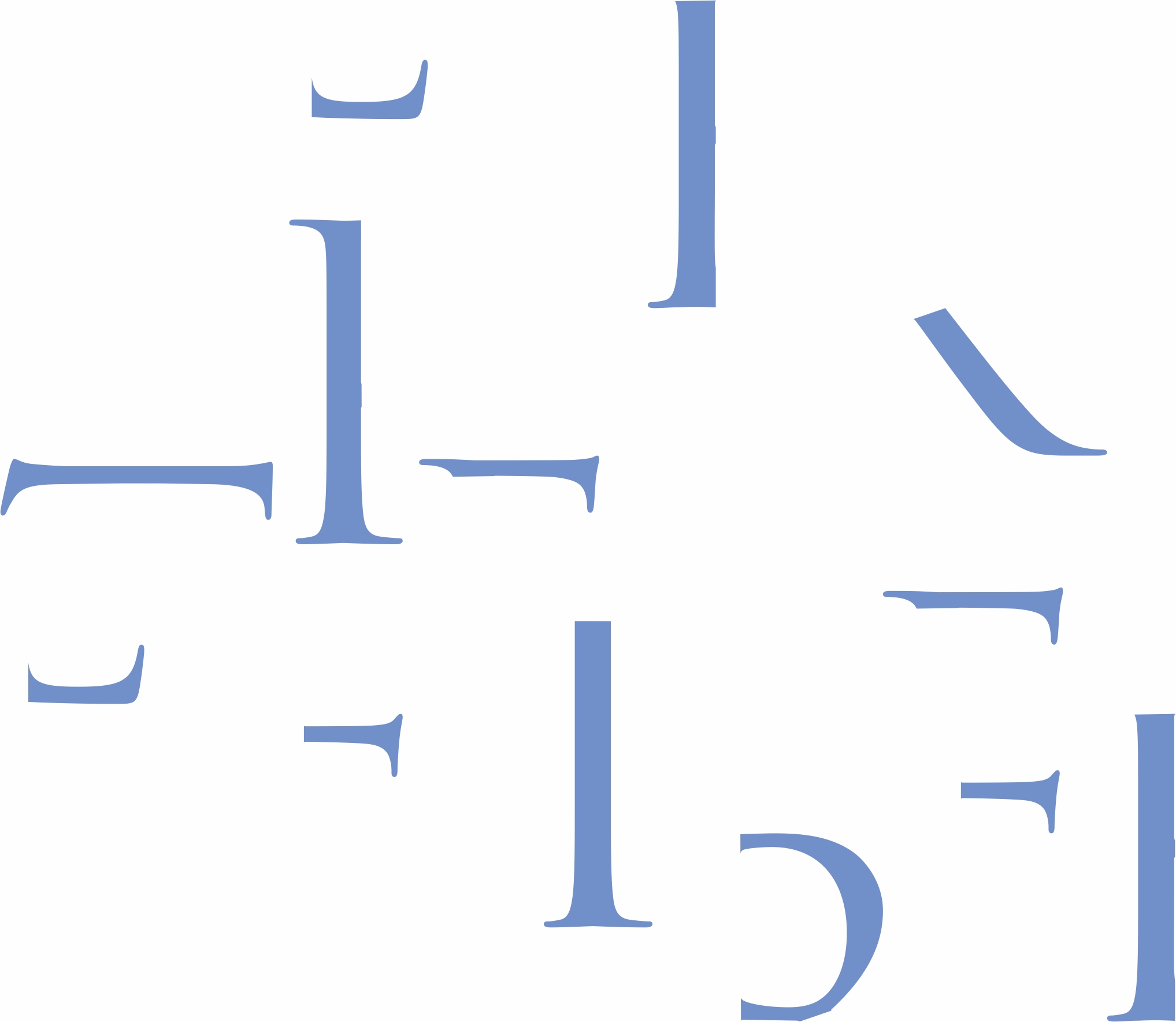![]()
 Can you make sense of those lines in the image to the right? Of course not. They’re deconstructed from the letters of a simple, one-syllable word and randomly re-arranged. It’s just four letters, but their component parts are not arranged in the proper order, so they seem like meaningless lines and squiggles. We’ve not been taught to assemble them into a structure that makes sense to our brains. Yet we’re quite capable of assigning meaning and context to abstract forms, if they’re assembled properly.
Can you make sense of those lines in the image to the right? Of course not. They’re deconstructed from the letters of a simple, one-syllable word and randomly re-arranged. It’s just four letters, but their component parts are not arranged in the proper order, so they seem like meaningless lines and squiggles. We’ve not been taught to assemble them into a structure that makes sense to our brains. Yet we’re quite capable of assigning meaning and context to abstract forms, if they’re assembled properly.
The order that we prefer those lines and curves to be in is arbitrary – the association of any particular line or curved with another piece is simply a convenience we all agree to use. Other cultures, other languages have a different agreement, equally arbitrary. The lines that form a lamed in the Hebrew alphabet don’t look anything like the lines we use to make an “L” but they get translated into that sound in the reader’s brain because that’s what the reader was raised to expect. Similarly, a Cyrillic “L” looks different from both English and Hebrew, yet performs the same function in the language. When a non-Hebrew or non-Cyrillic reader sees them, they recognize the lines, but there is no neurological association to tell that reader what they mean.*
 When those lines and curves are again aligned differently, they offer a hint of order. English readers can more easily recognize some of the forms, even if they don’t always coalesce into specific letters. You might be able to guess at some of the letters, maybe even all., but most likely the word itself remains obscure unless you put a lot of cogitative effort into solving the puzzle.
When those lines and curves are again aligned differently, they offer a hint of order. English readers can more easily recognize some of the forms, even if they don’t always coalesce into specific letters. You might be able to guess at some of the letters, maybe even all., but most likely the word itself remains obscure unless you put a lot of cogitative effort into solving the puzzle.
Yet even if you can’t figure it out, our brains are remarkably agile in that they are eager to build associations from even the smallest clues. That’s how pareidolia happens – described on Wikipedia as, “…a psychological phenomenon in which the mind responds to a stimulus, usually an image or a sound, by perceiving a familiar pattern where none exists (e.g. in random data).” But while it makes for imagined faces of Jesus on grilled cheese sandwiches, it also helps us identify things that are not in the exact shape and form that we expect.
 By now, you should be easily able to identify all the letters and the word they spell. While still not arranged exactly as they ought to be, they are close enough that our agile brains can build the correct associations rapidly and easily. That’s part of the magic of reading. Not magic as in Harry Potter or in the pseudoscience claptrap like homeopathy passed off as magical medicine, but rather the amazing, almost inexplicable ability of the human brain to see a bunch of abstract symbols – lines and curves – and to associate them with an arbitrary shape, assign it a meaning and a sound, then assemble a group of those arbitrary symbols into another arbitrary collection we call a word, and then build a mental picture that represents that word.
By now, you should be easily able to identify all the letters and the word they spell. While still not arranged exactly as they ought to be, they are close enough that our agile brains can build the correct associations rapidly and easily. That’s part of the magic of reading. Not magic as in Harry Potter or in the pseudoscience claptrap like homeopathy passed off as magical medicine, but rather the amazing, almost inexplicable ability of the human brain to see a bunch of abstract symbols – lines and curves – and to associate them with an arbitrary shape, assign it a meaning and a sound, then assemble a group of those arbitrary symbols into another arbitrary collection we call a word, and then build a mental picture that represents that word.
 A tree. Poet Joyce Kilmer wrote she would never see, “A poem lovely as a tree.” But that’s simply poetic licence. Reading any poem is as lovely a dance of neurons and brain chemistry as any green leafy branch brushed by the wind. And when you read that your brain neurons fired in such a way that created images to reflected the meaning of those abstractions, turning them into words, and gave you an image of green leaves to relate it all to. Pretty magical, given that it all happened in a fraction of a second.
A tree. Poet Joyce Kilmer wrote she would never see, “A poem lovely as a tree.” But that’s simply poetic licence. Reading any poem is as lovely a dance of neurons and brain chemistry as any green leafy branch brushed by the wind. And when you read that your brain neurons fired in such a way that created images to reflected the meaning of those abstractions, turning them into words, and gave you an image of green leaves to relate it all to. Pretty magical, given that it all happened in a fraction of a second.
 Our brains are so agile, we can flip these lines and curves around and still read them into a cohesive word backwards. That’s despite not having been taught to do so: it comes naturally, although it can be improved with practice. When I was a reporter, I often saw documents on someone’s desk, something I wasn’t always supposed to see, but being upside down from my perspective, I wasn’t expected to be able to read them. I developed my skill in reading them from practice and often gleaned considerable insight and information for my articles. Our brains are that plastic that we can do such wondrous things.
Our brains are so agile, we can flip these lines and curves around and still read them into a cohesive word backwards. That’s despite not having been taught to do so: it comes naturally, although it can be improved with practice. When I was a reporter, I often saw documents on someone’s desk, something I wasn’t always supposed to see, but being upside down from my perspective, I wasn’t expected to be able to read them. I developed my skill in reading them from practice and often gleaned considerable insight and information for my articles. Our brains are that plastic that we can do such wondrous things.
 Even when we jumble the letters, as long as we know they form a recognizable word, we can usually figure it out and put the letters into the right order. Our brains look at the letters of “rete” and reject it as a word because it’s not in our neural dictionaries. No images are associated with it. Same with “reet,” “rtee” and other combinations (although we may also see it as “etre” or “eret” – actual words in French and transliterated Hebrew, respectively, although neither means “tree”).
Even when we jumble the letters, as long as we know they form a recognizable word, we can usually figure it out and put the letters into the right order. Our brains look at the letters of “rete” and reject it as a word because it’s not in our neural dictionaries. No images are associated with it. Same with “reet,” “rtee” and other combinations (although we may also see it as “etre” or “eret” – actual words in French and transliterated Hebrew, respectively, although neither means “tree”).
When you come across such an unassociated word, you either stumble and stop, trying to figure it out, rebuild it into a recognizable form, or you skip past it. This is where context plays a big role.
Context, is of course, everything in determining how you respond to seeing those letters. If they show up as, say, someone’s nickname, you will recognize that and simply pronounce them, and you will build your associated image based on whatever dialogue or description is part of that personification. Like, “Dave ‘Rete’ Jones smiled thinly, shook his head and said in a posh London accent, ‘That’s not the right car, old chap,’ as he reached for the keys in the driver’s hand.”
But what if I write instead, “David Jones smiled thinly, shook his head and said in a posh London accent, ‘That’s rete the right car, old chap,’ as he reached for the keys in the driver’s hand.” You get stopped cold, trying to figure out what I meant by “rete” in the context of that sentence. Yet you may only pause slightly if I use a word that may while not commonplace in your daily vocabulary, has nonetheless lodged in your brain’s dictionary at some point: “That’s not the right car, for a wee bairn like you,” or “I dinnae ken you can drive that in your state.” (Assuming you’ve heard or read those Scottish words in the past).
Those words will also change the other associations and build the mental image created by reading them in a new way.
Your neurons are firing like sportbike cylinders as you read, active in a way they aren’t with TV or many video games. These provide the associations visually (and aurally), which means your brain doesn’t need to work very hard to assemble the context; just passively absorb the content. In effect, reading makes your brain work harder, like exercise does with muscles, thus helps make you smarter. Watching TV is entertainment: reading is thinking.
 What do you see here? This is one form of Dr. David Kelly’s square words calligraphy I used to spell tree. It might seem unusual when you first look at it, but knowing what it says makes it much easier to understand how it deviates from the familiar structures. It becomes a sort of mental puzzle, or game, that we seek to decipher. It’s amazing how quickly we adapt to being able to read it.
What do you see here? This is one form of Dr. David Kelly’s square words calligraphy I used to spell tree. It might seem unusual when you first look at it, but knowing what it says makes it much easier to understand how it deviates from the familiar structures. It becomes a sort of mental puzzle, or game, that we seek to decipher. It’s amazing how quickly we adapt to being able to read it.
There are some fun examples of this calligraphy on the Omniglot site including four short parables written in one of his alphabets for you to decipher (and worth doing just for the fun of it, even if you’re not interested in languages and reading per se). Once again, what at first seems like another language gets resolved in your brain into something more familiar.
Take a look at this, the opening of The Miller’s Tale from Chaucer’s Canterbury Tales. It contains a mix of archaic words no longer in common use, as well as variant spellings of otherwise common words. The letter forms are the same, but because this was written more than 600 years ago, they appear in an unfamiliar order or association.** How many words stop your reading, and how many of those can you figure out from context?
Whilom ther was dwellynge at Oxenford
A riche gnof, that gestes heeld to bord,
And of his craft he was a carpenter.
With hym ther was dwellynge a poure scoler,
Hadde lerned art, but al his fantasye
Was turned for to lerne astrologye,
And koude a certeyn of conclusiouns,
To demen by interrogaciouns,
If that men asked hym in certain houres
Whan that men sholde have droghte or elles shoures,
Or if men asked hym what sholde bifalle
Of every thyng; I may nat rekene hem alle.
For me, it was whilom (once), gnof (churl or peasant), koude (knew) and demen (deem). The rest I found relatively easy to read and even when I paused, often by simply pronouncing the word aloud made its meaning clear. I have read a fair amount of Chaucer in Middle English over the past decade, so perhaps I’m a trifle more familiar with it than you, gentle reader, may be, but it’s not an elitist position: it only takes a bit of effort to make the text as clear as anything you might read in a book today. (Doing so makes Chaucer far more a delightful read, with its rhyming and its puns, than in a modernized edition).
My point here is to reiterate how marvellous our agile brains are at figuring out what words means even though they’re not in the form we have been taught or expect. The brain is not daunted by the unfamiliar and will seek to find meaning where it can. And where it gets befuddled, it may assign something anyway, desperately seeking meaning in often random content or simply poorly visualized (which can explain ghosts, UFOs and other imagined phenomena).
Because reading is a neural performance, a complex activity, and not a passive act, your brain slips into gear with each word and rapidly hunts among its neural shelves and storage boxes for associations that allow you to build a mental image for each word. Every sentence you read here has created a wealth of images and associations, but it’s nothing like those created when you read a story or a novel. It’s remarkably like magic.
~~~~~
* You may not recognize any of the letters or words in, say, Cryllic, Hebrew, Vietnamese or Tibetan, but you probably recognize rather quickly that they are languages, with symbols like English. That’s another bit of magic that allows us to translate other languages into our own, although translation is a different process and as much an interpretive art as a discipline. More on translation in another post.
** By Chaucer’s time, Middle English was in use. The four additional symbols in the Old English alphabet (ash, eth, thorn and wynn) had been replaced with regular letters or combinations that represented their sounds. For example, the “thorn” or “þ” had become “th”. Because of its original appearance in handwritten documents, the symbol of the thorn was later confused with a “y” – thus the misspelling “ye olde” instead of the more correct “the olde.”


http://uk.businessinsider.com/students-learning-education-print-textbooks-screens-study-2017-10